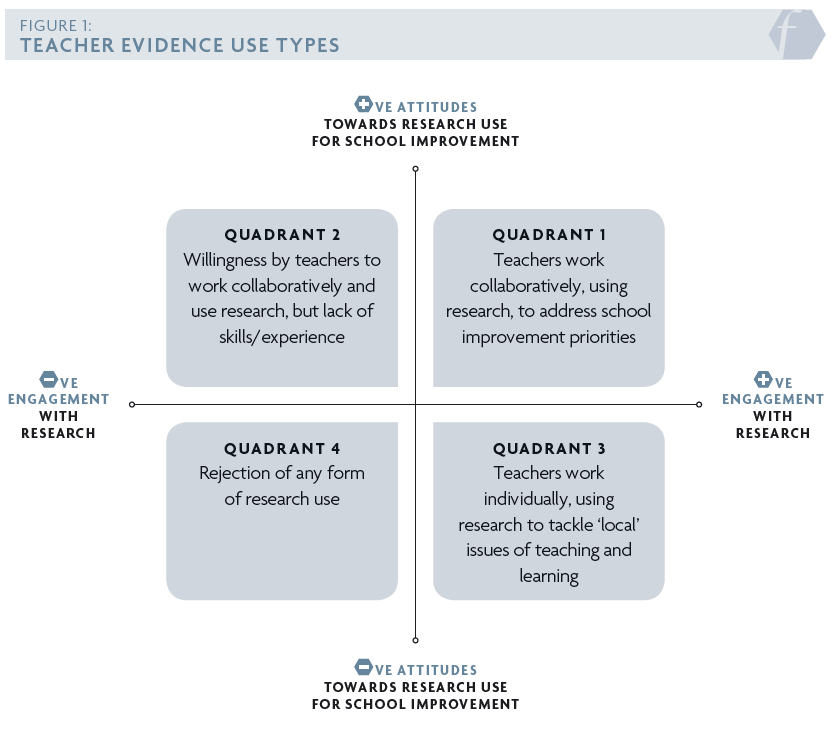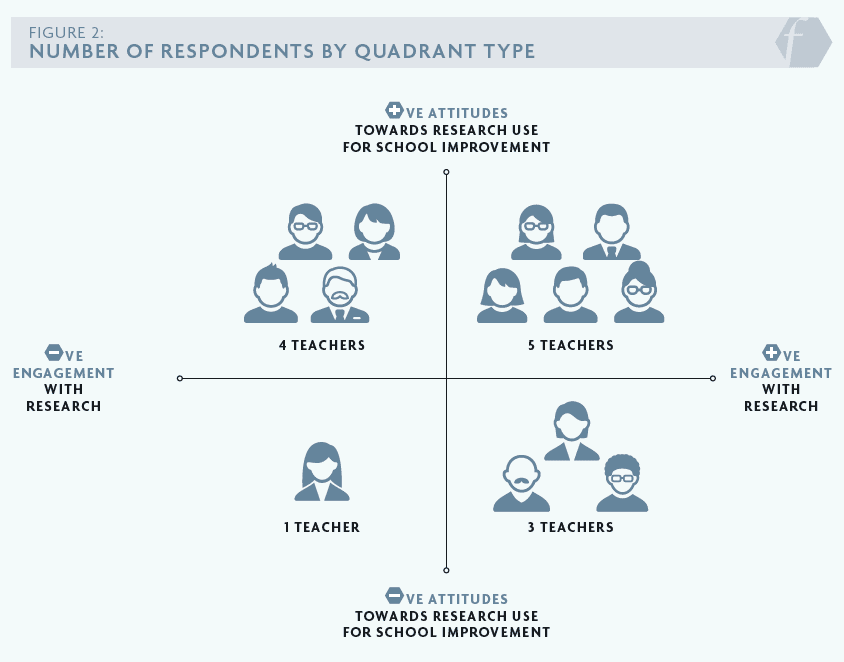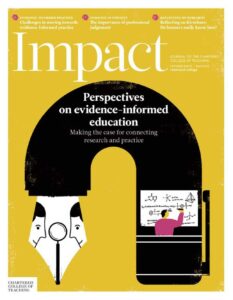Exploring the role of ‘research capital’ in delivering school and school system improvement: A case study of Chestnut Learning Federation

Evidence-informed practice
Evidence-informed practice (EIP) is defined as the process of teachers accessing, evaluating and applying the findings of academic research in order to improve their teaching practice (Walker, 2017). Considered to be the hallmark of high-performing education systems (Furlong, 2014; Supovitz, 2015), EIP is regarded by many as a prerequisite for effective teaching and learning (Furlong, 2014; See et al, 2016). It is also suggested (e.g. OECD, 2016) that optimal forms of EIP involve teachers collaborating to use research to address school priorities, where these priorities coincide with the day-to-day realities of the classroom (e.g. teachers’ use of research to improve pupil behaviour or pedagogy). At the same time, little research has been undertaken into how this optimal situation can be achieved (Cain, 2015).
Types of teacher evidence use and ‘research capital’
Recent studies examining the use of research by teachers (e.g. Brown and Zhang, 2016; Stoll and Brown, 2015) suggest that it is possible to characterise teachers’ EIP behaviours according to a combination of their attitudes towards using research for school improvement and teachers’ engagement with research. Conceiving teachers’ research-use attitudes and engagement as forming the axes of a 2 x 2 matrix (see Figure 1), these studies point towards four evidence-use ‘types’: type 1 teachers work collaboratively using research to address school improvement priorities; type 2 teachers are those who are willing to work collaboratively to engage with research, but who lack the skills/experience required; type 3 teachers are those who work individually, using research to tackle ‘local’ issues of teaching and learning; and finally, type 4 teachers reject any form of research use.
Drawing on the idea of other forms of capital, such as social and cultural capital (e.g. Bourdieu, 1986), I suggest that the notion of research capital (RC) corresponds to situations in which teachers both can and wish to use research collaboratively to improve teaching and learning, with higher levels of research capital being more optimal in nature. This means, in terms of school and school system improvement, it would seem preferable for schools to have a high number of teachers who are type 1 evidence users. It is also clear that, based on their attitudes and experience, if type 1 teachers have the highest levels of research capital, then type 4 teachers have the lowest, with type 2 and type 3 teachers possessing intermediate levels of RC. Ideally then, schools that are seeking to be research-engaged should be attempting to foster type 1 behaviour amongst their entire teaching staff. As yet, however, no research has been undertaken into whether individual schools tend to have a predominance of teachers of any given type, or why this might be the case, or how levels of research capital can be raised.
The research informing this article examines these four evidence-use types in more detail to ascertain what leads to teachers possessing higher or lower levels of research capital. It also examines the distribution of teachers by quadrant in one school federation in Hampshire. The article concludes with suggestions for how this federation, as well as schools more generally, can work towards developing higher levels of RC and the strategies school leaders might use to develop teachers into type 1 research users.
Chestnut Learning Federation: seeking to become research-engaged
The Chestnut CE Learning Federation is a family of three small church infant schools based in the Hampshire villages of Rosebush, All Saints and Southampton Common, who all work closely together under the leadership of the Federation’s head teacher and governing body. The vision of the three schools is to ensure children grow up to lead safe, happy, healthy and successful lives by providing the highest standard of education and the opportunity for each child to attain their own, full potential. One of the Federation’s improvement plan objectives is for it to become an evidence-informed federation where schools collaborate to rigorously evaluate the quality of the education they offer, understand what they need to do to improve, take appropriate evidence-informed actions and evaluate the impact of their actions, enabling them to achieve together.
To meet this objective, the executive head teacher of the Federation has developed a model of professional learning where (as from the 2016/17 school year) four of the statutory staff in-service educational training (INSET) days allocated to schools in England will be dedicated solely to evidence-informed professional development. Using a cycle of enquiry approach, the aim of the model is to enable teachers to engage collaboratively with research, to develop new practices, to trial these practices, to measure their impact and then to roll out the most successful within and across schools in the Federation.
A qualitative methodology was employed to explore both the context for the roll out of the Chestnut’s model for research engagement, and what is required from this approach if it is to move the Federation towards the optimal position of high research capital. Specifically, in-depth semi-structured interviews were used to identify the research use types displayed by Chestnut’s staff and the factors that seemingly led to staff engaging in specific forms of research use. A total of 13 teachers were interviewed in September 2016 (representing the whole of the Federation’s teaching staff). The characteristics of the respondents are set out in Table 1. Interviews were recorded, and these recordings were transcribed. Data from the recordings was organised according to each research use type and then analysed thematically. The number of respondents by each quadrant type is provided in Figure 2. Overall findings for each type are set out in the next section.
Overall findings
Overall, a summary of the main findings indicates that:
Type 1 teachers had a firm understanding of the benefits of employing research, felt it provided an exciting vision for the future and felt that senior leaders (both at school and federation level) were encouraging them to experiment using research-informed approaches to realise these benefits/this vision. Teachers in this quadrant believed in the importance of collaboration and in maximising the benefits of being in a network and, because of this, viewed EIP as having value that went beyond the individual classroom: i.e. that EIP should involve collective endeavour to enable teachers to harness the benefits of the social capital potentially available to them. At the same time, respondents in this quadrant also regarded research use as providing them with a secure knowledge base upon which to engage in collaborative networked activity.
Type 2 teachers recognised that senior leaders were encouraging them to use research-informed approaches and were happy to consider engaging in EIP, since this both represented a natural extension of and supported existing collaborative activity (e.g. networked learning conversations). They also saw EIP as helping them fully develop an enquiry habit of mind. Although these teachers were yet to fully understand the practical benefits of evidence-informed practice, they were cognisant of the costs required to engage in EIP effectively.
Type 3 teachers, perhaps because of time pressures, held different views. While they understood the benefits of employing research, they considered EIP primarily as a ‘tool’: something relevant to tackling local (classroom-level) issues, rather than something to be used collaboratively to tackle the strategic and more distant goals of the network. As a consequence, teachers in this quadrant were more likely to use research solely to develop their professional autonomy: to try out new strategies and build up a repertoire of research-informed pedagogies that focused solely on day-to-day student issues.
Type 4 research users: only one respondent indicated that they rejected any form of research use. While it is not desirable to report on the findings of one individual, for reliabilityIn assessment, the degree to which the outcome of a particular assessment would be consistent – for example, if it were marked by a different marker or taken again and ethical reasons, of interest is that while respondents located in the other three quadrants universally linked EIP to solving problems, developing an enquiry habit of mind (OECD, 2016), becoming a reflective practitioner and developing 21st-century learning amongst pupils, this respondent linked EIP directly to performativity and accountability.
As well as examining findings across individual quadrants, it is also possible to undertake a ‘cross case’ approach to examine the factors that inform respondents’ attitudes towards research use for school improvement as well as their engagement with research. Beginning with the latter, and examining data from both quadrants 1 and 3, it would seem that key to driving participants’ actual use of research is their first-hand engagement with research. For instance, those participants who recognised the benefits of using research were those who had typically recently completed postgraduate study.
A fundamental part of what drives positive attitudes towards research use for school improvement, on the other hand, is the extent to which the use of research is perceived as being something that should extend beyond the local setting – in other words to teachers’ collaborative and networked orientations (e.g. their use of learning conversations and networked learning conversations) – and the extent to which evidence-use signifies not just a tool, but something that leads to 21st-century teaching and learning within what the OECD refers to as ‘learning organisations’ (OECD, 2016).
Related is the recognition from teachers within quadrants 1 and 2 that senior leaders in the Federation are encouraging of the EIP agenda and, vitally, also engaging in acts (such as timetabling) to enable networked collaboration. Where participants held negative attitudes towards research use for school improvement, they highlighted a lack of support to encourage them to engage in research use that involved collaboration with colleagues (most often citing competing priorities as the reason that EIP was only likely to materialise locally).
Situating these findings more widely, it is clear that they both cohere with and augment other work in the areas of research use and educational change at the system level. They also provide vital insights if Chestnut Learning Federation is to achieve its improvement plan objectives to become an evidence-informed federation. To begin with, the findings reaffirm the vital importance of first-hand experience if individuals are to buy in to new ways of working, such as that represented by using research evidence (e.g. Fullan, 2011). Also, teachers need to feel able to experiment if they are to fully engage in EIP-type activity (e.g. Katz et al ., 2009). Key to increasing engagement with research amongst teachers in the Chestnut Learning Federation, therefore, is that the Federation works to ensure teachers are able to engage with and apply research when attempting to improve their practice and that they can recognise the value of doing so.
These findings also reaffirm that senior leader support is key to fostering a culture of research use. Such conditions include coordinated and protected time and space, as well as access to relevant research resources (Galdin-O’Shea, 2015). Senior leadership support is also essential for networked activity to take root and flourish (Rincon-Gallardo and Fullan, 2016). Support in these areas is most effectively delivered via a mixture of transformational leadership strategies, and school leaders ‘walking the talk’: showcasing the research-related behaviours expected of staff (Southworth, 2009).
In particular, however, the findings from this study highlight the requirement for Chestnut Learning Federation to promote the idea of community while also ensuring that staff are both encouraged and supported to engage in research use in a networked and collaborative way. Here, all staff must move beyond the superficial exchange of practices and resources and towards meaningful research-related collaboration that has demonstrable benefits for both individual teachers and the Federation as a whole. That is, to support type 1-type perspectives, school leaders in the Federation need to ensure all teachers act more readily in the spirit of what Brown and Zhang (2016) refer to as the culture of the networked research learning community, and it is this use of networks, in ways that can produce a multitude of benefits at a variety of levels, that is likely to be the key to unlocking the potential that the optimal rational position of EIP has to offer.
References
Bourdieu P (1986) The forms of social capital. In Richardson JG (ed) Handbook of Theory and Research for the Sociology of Education. New York: Greenwood, pp.241-258.
Brown C and Zhang D (2016) Is engaging in evidence-informed practice in education rational? Examining the divergence between teachers’ attitudes towards evidence use and their actual instances of evidence use in schools. British Educational Research Journal 42(5): 780-801.
Cain T (2015) Teachers’ engagement with published research: Addressing the knowledge problem. Curriculum Journal (26)3: 488-509.
Fullan M (2011) Change Leader: Learning to do What Matters Most. San Francisco: Jossey-B Bass/Wiley.
Furlong J (2014) Research and the Teaching Profession: Building Capacity for a Self- Improving Education System. Final Report of the BERA-RSA Inquiry into the Role of Research in the Teaching Profession. London: BERA.
Galdin-O’Shea H (2015) Leading ‘disciplined enquiries’ in schools. In Brown C (ed) Leading the Use of Research and Evidence in Schools. London: IOE Press, pp.91-106.
Katz S, Dack L A and Earl L (2009) Networked learning communities: Fostering learning for teachers and the students. Principal Connections 12(3): 36-38.
OECD (2016) What makes a school a learning organization? Available at: http://www.oecd.org/education/school/school-learning-organisation.pdf (accessed 25 July 2016).
Rincón-Gallardo S and Fullan M (2016) Essential features of effective networks in education. Journal of Professional Capital and Community 1: 5-22.
Roberts C (2015) Impractical research: Overcoming the obstacles to becoming an evidence-informed school. In: Brown C (ed) Leading the Use of Research and Evidence in Schools. London: IOE Press, pp.107-116.
See BH, Gorard S and Siddiqui N (2016) Teachers’ use of research evidence in practice: A pilot study of feedback to enhance learning. Educational Research 58(1): 56-72.
Southworth G (2009) Learning-centred leadership. In: Davies B (ed) The Essentials of School Leadership (2nd edn). London: SAGE Publishing, pp.91-111.
Stoll L and Brown C (2015) Middle leaders as catalysts for evidence-informed change. In: Brown C (ed) Leading the Use of Research and Evidence in Schools. London: IOE Press, p.66-77.
Supovitz J (2015) Teacher data use for improving teaching and learning. In: Brown C (ed) Leading the Use of Research and Evidence in Schools. London: IOE Press, pp.117-125.
Walker M (2017) Insights into the Role of Research and Development in Teaching Schools. Slough: NfER.
Warren Little J (1982) Norms of collegiality and experimentation: Workplace conditions of school success. American Educational Research Journal 19(3): 325-340.
This article was published in May 2017 and reflects the terminology and understanding of research and evidence in use at the time. Some terms and conclusions may no longer align with current standards. We encourage readers to approach the content with an understanding of this context.













